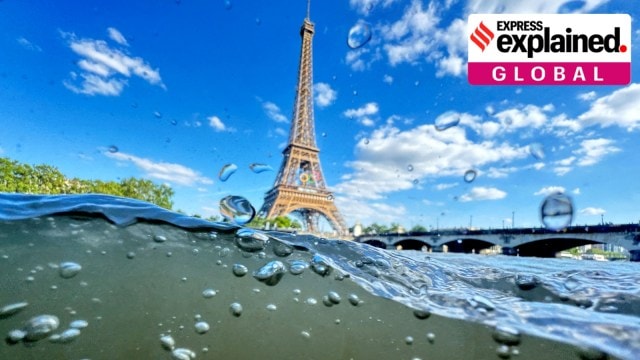Will Paris be able to fix Seine’s ‘poop’ problem in time for Olympics?
The river Seine, which is set to host two Olympic events, remains too dirty and dangerous to swim in. As the Games approach, will Paris be able to fix the problem?
 The Seine has defined the city of Paris since Roman times. (REUTERS/Pawel Kopczynski)
The Seine has defined the city of Paris since Roman times. (REUTERS/Pawel Kopczynski)The Paris Olympics has a ‘poop’ problem. Despite the organisers’ all-out efforts, the Seine river remains too dirty — and dangerous — to swim in. Apart from the boat parade during the opening ceremony, the Seine is supposed to host the marathon swimming, and triathlon (the swimming leg) events.
To reassure competitors and the public about the Seine being safe, Paris Mayor Anne Hidalgo swam in the river on Wednesday (July 17). Last Saturday, Sports Minister Oudéa-Castéra and Paralympic flag bearer Alexis Hanquinquant too took a dip in the Seine.
Nonetheless, there is still widespread skepticism about whether the river will be ready in time for the Games, which kick off on July 26.
The dirty Seine
The Seine is notorious for being filthy. This is because of Paris’ aged sewage system in which rainwater and wastewater flow in the same pipes. During heavy spells of rain, these pipes reach their capacity and start to overflow — this leads to untreated sewage being directly discharged into the Seine, instead of going to a treatment plant first.
This contamination significantly increases the concentration of the E. coli bacteria in the river. Found in the faecal waste of humans and other animals, some strains of the bacteria can cause severe illness, including gastrointestinal and urinary tract infections (UTIs). The presence of this bacteria, thus, makes the Seine unsafe for swimming.
E. Coli concentration of upto 900 colony-forming units per 100 ml of water is considered to be safe for competitions, as per standards set by the European Union and the World Triathlon Federation. Following heavy rains on June 30, the Seine’s E. coli levels massively exceeded this threshold, sometimes by a factor of two. In fact, over a period of 30 days from June 3 to July 2, E. coli counts surpassed the safe levels on 22 days. After several days of rain, on June 18, E. coli levels in the Seine jumped to roughly 10,000 colony forming units per 100 ml — more than 10 times the safe limit.
The triathlon swimming events are scheduled for July 30 and 31, and August 5, while the marathon swimming events are set to take place on August 8 and 9. Water quality tests are mandatory 48 hours before each race — and there is no guarantee that the Seine will pass. Last year, numerous test events were canceled due to high pollution levels.
Billion dollar cleanup
To fix the Seine, Paris has spent 1.4 billion euros ($1.53 billion) improving its infrastructure.
In fact, at the time Hidalgo presented her winning bid for the 2024 Games back in 2016, she had promised to usher in a major environmental overhaul of the city. Key to this promise was to ensure that Olympic athletes can swim in the romantic river which has defined the city for a millenia, much like they had done in 1900, the last time Paris held the Olympics. Due to pollution, swimming has been banned in the Seine since 1923.
The centre piece of Paris’ solution for fixing the Seine is the creation of a giant underground rainwater storage tank in southeastern Paris, capable of holding enough water to fill up 20 Olympic-size swimming pools. Planners hope that this will hold most runoff water during heavy rains, preventing it from overwhelming the city’s sewage system.
Yet, extremely heavy rains can still overwhelm the system and contaminate the river, as has been seen in recent weeks. If the Seine remains unsuitable for swimming, organisers have come up with contingency plans. These include postponing events, or converting triathlons to duathlons by eliminating the swimming leg. For the marathon swimming event, the Vaires-sur-Marne Nautical Stadium, located outside Paris, is prepared as an alternative venue.
(The author is an intern at The Indian Express)
- 01
- 02
- 03
- 04
- 05






































